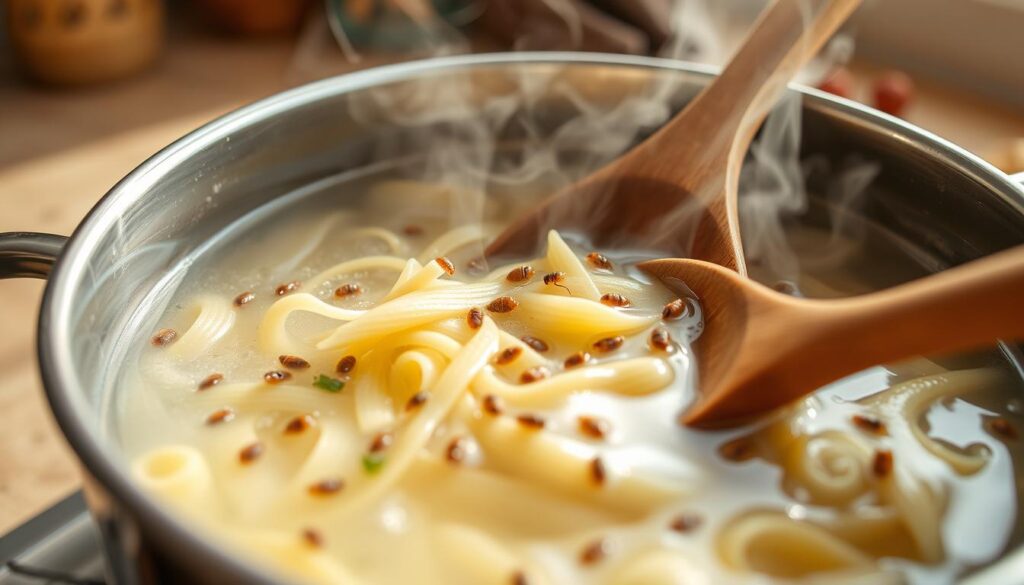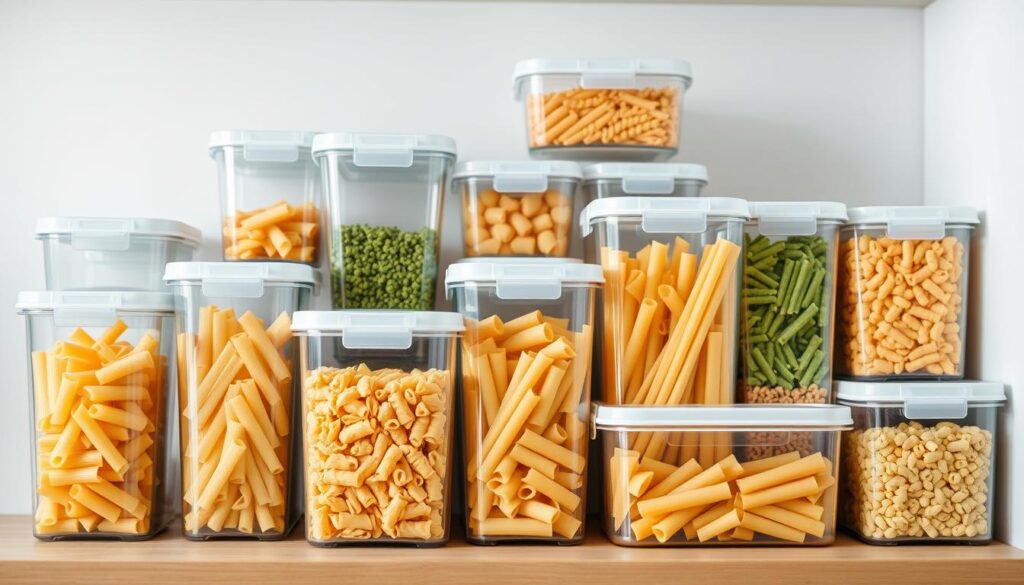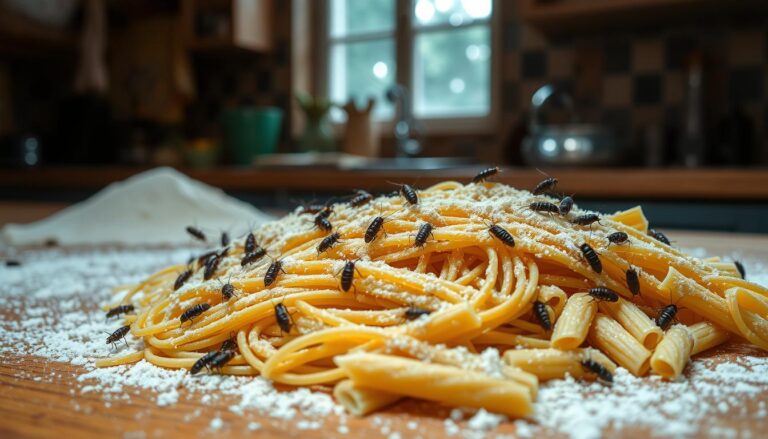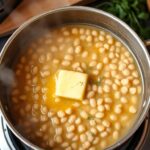Opening a box of pasta to find tiny bugs can be shocking. Weevils in your spaghetti or penne are unappetizing. But how safe is it to cook pasta with weevils?
Weevils are small beetles that infest pantry staples like pasta and flour. They’re harmless to humans but unwelcome in our food. If you’ve found weevils in your pasta, you’re likely concerned about safety.
Let’s explore how weevils end up in your noodles. We’ll assess food safety concerns and discuss ways to handle weevil-contaminated pasta. Before tossing that box, learn if you can save your dinner plans.
Key Takeaways
- Weevils are common pantry pests that infest dry goods like pasta, flour, and grains
- While alarming, weevils are not harmful to human health if accidentally consumed
- Proper inspection and removal techniques can help salvage weevil-infested pasta
- Prevention through proper storage is key to avoiding weevil infestations
- Severe cases may require discarding the contaminated pasta for quality and peace of mind
Understanding Weevils in Pasta
Weevils can infest dry pasta, causing frustration and food waste. These tiny insects invade pantries, making your pasta inedible. Learn how to handle weevils in dry pasta by understanding their nature and origin.
What Are Weevils?
Weevils are small beetles from the Curculionidae family. The most common type affecting stored grains is the grain weevil (Sitophilus granarius). These tiny insects have elongated snouts and hard bodies.
They rarely grow longer than 6 millimeters. Weevils won’t harm you if eaten by accident. However, their presence is unappetizing and may lead to wasted food.
Weevils are not harmful to humans if accidentally consumed, but their presence can be unappetizing and may cause food waste.
How Do Weevils Get into Pasta?
Weevils can infest pasta at many stages of the food supply chain. This includes during grain cultivation, harvest, and warehouse storage. They can also invade during transportation, on store shelves, or in your pantry.
- During grain cultivation and harvest
- While grains are stored in warehouses
- During transportation to stores
- In grocery store shelves
- In your home pantry
Female weevils lay eggs on or inside grains. When conditions are right, the eggs hatch into larvae. The larvae feed on grains, growing into adult weevils.
This cycle can continue indefinitely if not stopped. It may lead to a full-blown infestation of these pantry pests.
| Stage | Duration |
|---|---|
| Egg | 3-7 days |
| Larva | 2-3 weeks |
| Pupa | 1-2 weeks |
| Adult | 2-3 months |
Understanding grain weevils’ life cycle and habits is crucial. This knowledge helps you prevent infestations and protect your dry pasta. Take action to keep these persistent pests away from your pantry.
Identifying Weevil Infestations
Weevils are small pests that can sneak into your pantry. These tiny beetles love to infest pasta, making a mess. Knowing how to spot weevils is key to protecting your food.
Signs of Weevils in Pasta
Spotting weevils in pasta isn’t hard if you know what to look for. Here are some signs that can help you find an infestation:
- Small, brownish beetles or larvae in the package
- Holes in the pasta shells or visible damage
- Pasta granules sticking together as if caught in a cobweb
- Adult weevils crawling on the walls or shelves of your pantry
If you see these signs of weevil infestation, it’s time to act. Don’t let these bugs ruin your Mexican pasta dish, Fideo, or other pasta meals.

Inspecting Pasta Packages for Weevils
Stopping weevils before they spread is crucial. Check your pasta packages before cooking. Here’s how to inspect pasta for weevils:
- Examine the outside of the package for any holes or damage
- Gently shake the package and listen for any unusual sounds
- Open the package and carefully pour the pasta onto a clean, white surface
- Look for any movement or visible insects among the pasta
- Check for any clumps of pasta that may indicate a cobweb-like substance
Remember, identifying weevils in food is crucial for maintaining a healthy and pest-free kitchen. Don’t let these tiny invaders ruin your culinary adventures!
If you find weevils, throw away the package right away. Don’t try to save the unaffected pasta. It’s not worth risking a bigger infestation in your pantry.
Food Safety Concerns with Weevil-Infested Pasta
Food safety is crucial when dealing with weevil-infested pasta. Eating a few weevils likely won’t harm you. However, consuming large quantities of weevils can be risky.
Weevil contamination may signal other issues like mold growth. It could also indicate the presence of additional contaminants that pose health risks.
Weevils don’t usually carry diseases harmful to humans. However, some people may have allergic reactions to insects.
Symptoms of a weevil allergy may include:
- Skin irritation or rash
- Itching or swelling in the mouth or throat
- Difficulty breathing
- Abdominal pain or nausea
If you suspect an allergic reaction after eating weevil-infested pasta, seek medical help quickly.
Eating weevil-infested pasta may cause other digestive problems. Weevils can introduce bacteria into the pasta. This may lead to stomach discomfort if eaten in large amounts.
To reduce risks, inspect and handle pasta packages properly. Learn more about food safety in this informative article.
“Prevention is key for food safety and avoiding risks of weevil-infested pasta. Proper storage and regular pantry checks can greatly reduce weevil contamination chances.”
The choice to eat weevil-infested pasta is personal. Consider the severity of infestation and your comfort level. If in doubt, it’s best to throw away the affected product.
Can You Still Cook Pasta with Weevils?
Finding weevils in your pasta can be unsettling. It’s not ideal, but there are things to consider before throwing it out. Let’s explore if it’s safe to cook and eat weevily pasta.

Risks and Considerations
Cooking pasta with weevils has some risks. Weevils aren’t harmful to humans, but they can be unpleasant. Their presence might mean a larger pantry infestation.
Weevils may have laid eggs in the pasta. These eggs can be hard to remove completely. Think about these factors before cooking weevil-infested pasta.
- The severity of the infestation
- The presence of eggs or larvae
- The psychological impact of consuming insects
- The potential for spreading the infestation to other food items
Techniques for Removing Weevils from Pasta
If you decide to cook weevil-infested pasta, try these methods. They may help remove weevils, but might not get rid of all traces.
- Sift through the pasta and manually remove any visible weevils
- Rinse the pasta thoroughly under running water to dislodge weevils
- Cook the pasta in boiling water, which will kill any remaining weevils
- Strain the cooked pasta and inspect it for any remaining insects
“While it’s possible to remove some weevils from pasta, it’s important to understand that these methods may not eliminate all traces of the insects or their eggs. Ultimately, the decision to cook and consume weevil-infested pasta is a personal one that should be made with careful consideration.”
Assess the infestation’s severity when deciding to salvage weevily pasta. Consider the risks and how you feel about eating insects. If you’re unsure, it’s better to throw out the pasta.
Take steps to prevent future infestations in your pantry. This will help avoid similar situations in the future.
| Severity of Infestation | Recommended Action |
|---|---|
| Minor (a few visible weevils) | Remove visible weevils and cook pasta thoroughly |
| Moderate (several weevils, no eggs visible) | Carefully consider risks and personal comfort level before cooking |
| Severe (many weevils, eggs or larvae present) | Discard pasta and thoroughly clean pantry to prevent spread |
Cooking Methods for Weevil-Contaminated Pasta
Weevils in your pasta can be troubling. Cooking might help, but it’s crucial to know the risks and techniques. Let’s explore how to handle weevil-infested pasta safely.
Boiling and Straining Techniques
Boiling weevil-infested pasta can kill the insects. Follow package instructions for cooking time. However, this won’t remove their bodies from the pasta.
Use a fine mesh sieve to strain the cooked pasta. This catches floating weevils and debris. Rinse the pasta under running water for extra cleaning.
Inspecting Cooked Pasta for Weevils
After cooking, examine the pasta closely. Look for small, dark specks or movement on the surface. If you spot weevils or suspect severe infestation, discard the pasta.
“While cooking methods can help reduce the presence of weevils in contaminated pasta, it’s always better to prevent infestations in the first place by storing pasta properly and inspecting packages before use.”
Cooking kills weevils but doesn’t remove their bodies or potential contaminants. If you’re unsure about the pasta’s safety, it’s best to throw it away.
| Cooking Method | Effectiveness in Removing Weevils |
|---|---|
| Boiling | Kills weevils but may not remove bodies |
| Straining with fine mesh sieve | Catches floating weevils and debris |
| Rinsing under running water | Removes remaining insects and debris |
| Inspecting cooked pasta visually | Identifies any remaining weevils |
Cooking can help with weevil-infested pasta, but risks remain. Carefully inspect cooked pasta before eating. Proper storage and inspection are the best ways to prevent weevil problems.
Preventing Weevil Infestations in Pasta
Keep your pasta weevil-free by using proper storage techniques. Follow these steps to keep your pasta fresh and safe. Your pasta will stay weevil-free for a long time.

Proper Storage Techniques
Store pasta in airtight containers made of glass, plastic, or metal. This creates a barrier that prevents weevils from entering. Avoid storing pasta in its original packaging.
Transfer your pasta to airtight containers to reduce the risk of weevil infestations. Regularly inspect your pantry for signs of weevil activity.
Discard any infested products immediately to prevent the spread of weevils. Keep your pantry clean and organized to quickly spot potential infestations.
Using Airtight Containers and Freezing
Freeze your pasta for 3-4 days at 0°F (-18°C) to kill weevils and their eggs. This works well for newly purchased pasta before storing it.
After freezing, transfer the pasta to airtight containers to prevent reinfestation. Choose containers made of durable, non-porous materials like glass, metal, or high-quality plastic.
Make sure the containers have tight-fitting lids with a strong seal. Pick containers that fit the amount of pasta you usually store.
- Material: Choose containers made of durable, non-porous materials such as glass, metal, or high-quality plastic.
- Seal: Ensure that the containers have tight-fitting lids with a strong seal to prevent weevils from entering.
- Size: Select containers that are appropriately sized for the amount of pasta you typically store to minimize excess air space.
Use proper storage and freezing methods to protect your pasta from weevils. You’ll always have fresh, quality pasta ready when you need it.
Alternatives to Cooking Weevil-Infested Pasta
Found weevils in your pasta? Don’t worry! There are other options to consider. Try rice, quinoa, or other grains instead. These alternatives work well in many recipes.
You can also repurpose infested pasta for non-food uses. Use it in art projects or compost it. This reduces waste and finds creative uses for affected pasta.
When life gives you weevils, make art!
Here are some ideas for replacing infested pasta with other grains or repurposing it:
- Cook rice, quinoa, or couscous as a substitute for pasta in your favorite dishes
- Use infested pasta in art projects, such as making pasta jewelry or creating mosaics
- Compost the weevil-infested pasta to enrich your garden soil
- Donate the affected pasta to local farmers or animal shelters for use as animal feed
Check how much pasta is affected by weevils. You might save unaffected portions for cooking. If the problem is widespread, look for other options.
| Alternative Grains | Cooking Time | Nutritional Benefits |
|---|---|---|
| Brown Rice | 45-50 minutes | Rich in fiber, vitamins, and minerals |
| Quinoa | 15-20 minutes | High in protein, fiber, and antioxidants |
| Couscous | 5-10 minutes | Good source of selenium and plant-based protein |
Exploring alternatives to weevil-infested pasta helps reduce food waste. It ensures safe, nutritious meals for your family. Always choose safe options when dealing with pest-infested food.
When to Discard Weevil-Contaminated Pasta
Finding weevils in your pasta requires quick action. You need to check how bad the problem is. A few weevils may not be harmful, but a big infestation can cause issues.
Assessing the Severity of Infestation
Look for many live or dead weevils, larvae, or pasta damage. If you see lots of weevils or widespread contamination, throw the pasta away.
The University of Minnesota Extension suggests discarding weevil-infested pasta. This prevents the pests from spreading to other food items.
Considerations for Food Waste and Safety
Throwing away food due to pests can be troubling. However, food safety should be your top priority. Weevils can quickly spread to other foods if not dealt with.
When checking for weevils, think about the risks. If you’re unsure about the pasta’s safety, it’s best to throw it out. Quick action and proper food storage can help reduce waste.
FAQ
What are weevils, and how do they get into pasta?
Weevils are small beetles that infest dry foods like pasta and grains. They can enter pasta at any stage of food production or storage. Weevils lay eggs on grains, which hatch into larvae that eat the food.
How can I identify weevil infestations in my pasta?
Look for small, brown beetles or larvae in the package. Check for holes in the pasta or granules sticking together. You might also spot adult weevils crawling on pantry walls or shelves.
Inspect pasta packages carefully before opening them. This can help you spot signs of infestation early.
Is it safe to eat pasta with weevils?
Eating a few weevils by accident is unlikely to harm you. However, consuming large amounts of infested pasta can be risky. Weevils don’t usually carry diseases, but their presence may indicate other contamination issues.
Some people might have allergic reactions to insects. It’s best to be careful with weevil-infested pasta.
Can I cook and eat pasta with weevils?
Cooking weevil-infested pasta is possible but not recommended due to potential risks. You can try sifting, picking out visible weevils, and rinsing pasta before cooking. However, these methods may not remove all weevils or eggs.
The idea of eating insects can be unappetizing for many people. It’s usually better to avoid cooking infested pasta.
How can I prevent weevil infestations in my pasta?
Store pasta in airtight containers made of glass, plastic, or metal. Avoid keeping pasta in its original packaging, as weevils can chew through it. Regularly check your pantry and throw away any infested products.
Freezing pasta for 3-4 days at 0°F (-18°C) can kill weevils and their eggs. This is an effective prevention method.
When should I discard weevil-infested pasta?
It’s best to throw away pasta with severe weevil infestations. Look for signs like many weevils, larvae, or damaged pasta. If you’re unsure how long the pasta has been contaminated, it’s safer to discard it.
Getting rid of infested pasta helps prevent weevils from spreading to other food items. It’s better to be safe than sorry.
Source Links
- https://njaes.rutgers.edu/food-safety/bugs-in-my-cereal.php – I found bugs in my cereal, pasta or cake mix. What do I do? (Rutgers NJAES)
- https://aseannow.com/topic/1099282-weevils-in-dried-pasta-oh-the-horror/ – Weevils in dried pasta, oh the horror
- https://www.preparedsociety.com/threads/help-weevils-in-the-pasta.14284/ – Help! Weevils in the pasta!



